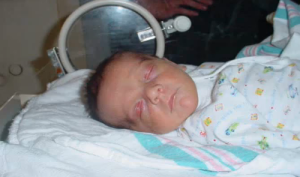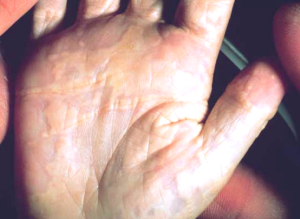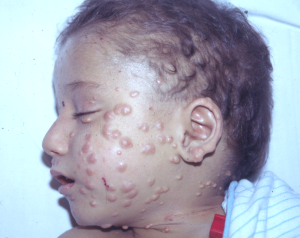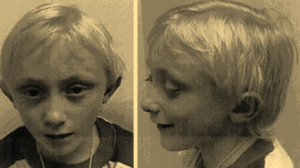Alagille syndrome is a genetic disorder that affects the liver, heart, kidneys, and other systems of the body. Problems associated with the disorder generally become evident in infancy or early childhood. The disorder is inherited in an autosomal dominant pattern, and the estimated prevalence of Alagille syndrome is 1 in every 100,000 live births.
Alagille syndrome is also sometimes known as arteriohepatic dysplasia or syndromic bile duct paucity.
Alagille syndrome symptoms
Alagille syndrome is associated with heart, liver, skeletal and eye disorders. They also possess different facial features, such as those discussed below:
- A striking forehead with a pointed chin that gives the face a triangle-like appearance
- The nose is quite straight
- The eyes are deep-set
The subjects affected by Alagille syndrome also elicit the symptoms associated with disorders of the different body systems such as:
- Liver problems such as:
- Ceasing of bile supply from liver
- Presence of a decreased number of bile ducts
- Jaundice which causes yellowish skin color
- Eye anomalies such as:
- Axenfeld’s disorder
- Posterior embryotoxon
- Renal disorders such as:
- Disorder of renal structures
- Renal tubular acidosis
- Congenital cardiac disorders such as:
- Any type of heart defect which normally tends to affect the right side of the
- Increased narrowing of the pulmonary artery
- Cardiac murmur
- Skeletal disorders such as:
- Decreased Interpedicular distance
- Short height or stature
- Butterfly shaped vertebrae
Causes of Alagille syndrome
Most cases of Alagille syndrome is caused by mutation in a gene called Jagged 1, found in chromosome 20. It is found that in about 5 % cases, the entire gene is missing from one copy of chromosome 20. In most cases of Alagille syndrome, random changes in the DNA sequence occur, which makes the Jagged 1 gene. In very few cases, another gene called Notch 2, cause Alagille syndrome.
Among the Alagille syndrome affected children, 1/3rd of them inherit the mutation in Jagged 1, from a parent. The rest 2/3rd of them have the mutation in Jagged 1, which are new ones. A parent with the mutated gene has fifty percent chances of passing it on to the child. The effect of inheriting mutation in Jagged1, may widely vary without indicating any reason for such wide differences
The nucleus of each cell has the structures called as chromosomes. Genes are contained within the chromosome. The genes are made up of a substance known as DNA, which provide the body a blue print, indicating the functioning and development. The mutation in the gene makes them to act disorderly or may make them non-functional.
The egg and sperm cells have 23 chromosomes with one copy of every gene. During fertilization, the fetus will inherit two copies of each gene, each one from mother and father. Alagille syndrome has an autosomal dominant pattern of inheritance and hence two copies of mutated genes are necessary for develop. When one copy of the gene (responsible for Alagille syndrome) has changes and becomes non-functional, then the loss may be compensated by the other copy of gene, which in turn does not result in the development of the signs and symptoms of Alagille syndrome.
In some cases, if the mutated gene dominates over the normally functioning gene, then it is also called as autosomal dominant, which will show up the signs of the condition. Thus the chances of inheriting autosomal dominant abnormality stand at 50%.
Diagnosis of Alagille syndrome
The Jagged 1 gene is identified in lab test by extracting DNA from blood sample. The affected child’s parents and other family members can go for carrier screening, once the mutation is identified. The family can avail the facility of prenatal diagnosis, in which the cells are collected by amniocentesis or by chorionic villus sampling. Here the fetal DNA from the cells tested to find whether the fetal has inherited a mutation. But it can’t confirm how severe it is.
Alagille syndrome treatment
Alagille syndrome has no known cure. The treatment methods are focused at enhancing the cardiac functions and also at alleviating the effects of compromised liver functionality. The treatments include:
Medications:
- A number of drugs such as Hydroxyzine, Ursodiol, Phenobarbitol, Cholestyramine, etc. have been prescribed to ease itching and improve the supply of bile, with different degrees of successful results
- A number of individuals affected by Alagille syndrome can also gain from an increased dose of certain multivitamins such as ADEK.
Surgery:
- Some of the cardiac abnormalities associated with Alagille syndrome can be corrected via surgery. The increased narrowing of the pulmonary arteries in the patients can be corrected via a process known as catheterization, which widens the affected arteries and eases the pressure on the cardiac pumping valves. Extreme cases of cardiac anomalies in Alagille syndrome patients may involve stenting to manually increase the arterial diameter
- Extreme liver abnormalities may be treated with a liver transplantation
Alagille syndrome pictures



